Some species of caterpillars have horns. 1-2 horns are seen across many species with some caterpillars having even more horns.
North America and Europe are among the common continents where caterpillars with horns live.
These horns can be short, long, or even not visible in the first growth stages of the caterpillar.
Table of Contents
Why do Some Caterpillars Have Horns?
Theories behind the horns of caterpillars are based on the self-defense principles which are evolutionary traits to keep predators away.
To keep predators away
Mostly ornamental, horns are an evolutionary trait that aims to scare off predators. Many fear these horns due to their color or their shape.
Horns can be bright, dark, or even black. They are often differently colored from the rest of the body so they stand out immediately.
While not truly dangerous to humans, some caterpillar horns may lead to skin-level reactions such as rashes or even dermatitis.
Caterpillars may rely on horns as a single line of defense or as one of the multiple strategies to avoid predation.
Living in groups is another strategy some species rely on to keep predators away.
Keeping predators away with a horn is often subject to having one horn only. One horn is typically seen at the rear of the body.
It may be perceived as a stinger, by different types of predators.
In reality, this horn has no type of function apart from being a visual deterrent.
Venomous horns with spikes are also not actively used by the species as they represent passive defensive mechanisms that only hurt predators in case of direct contact.
To be perceived as venomous
Most horns on caterpillars are black or colorful. Some may be brown while others may be green.
Multicolored red and yellow horns are further distinguishable on the species.
Some of these caterpillars absorb toxins from their hosts which makes them unpalatable for their predators which may perceive them as venomous and stay away.
Other types of caterpillars fully covered by horns (such as the Zebra Longwing Caterpillar) use a possibly-threatening look to keep larger predators such as birds away.
A higher density of horns also keeps smaller predators such as wasps away.
27 Caterpillars with Horns
Some of the most common North American caterpillars with horns include the following species.
1. Monarch Caterpillar

Monarch Caterpillars (Danaus plexippus) are among the most common caterpillars in North America. These caterpillars have black horns.
The horns of the species aren’t visible in its first instar. However, they grow from the second fifth instar, when they are the longest.
The first instar of this species is hornless. However, black spots are visible in the areas that later become long black horns.
Monarch caterpillars grow on milkweed and they have a long pair of horns at both ends of the body.
Black bands are also specific to its body and are mixed with yellow and white bands.
2. Pipevine Swallowtail Caterpillar

Pipevine Swallowtail Caterpillars (Battus philenor) show a similar path toward long horns as Monarch Caterpillars.
These caterpillars come in different colors such as red, orange, or black.
Horns grow on this species from the second instar.
The short horns seen in the first instars may sometimes be confused with the tubercles that cover the body of the Pipevine Swallowtail Caterpillar.
Caterpillars of this species remain active on their host plants, mainly in the pipevine Aristolochia genus until pupating.
This toxic plant is invasive and it may kill other caterpillars outside of its native range.
3. Soldier Caterpillar
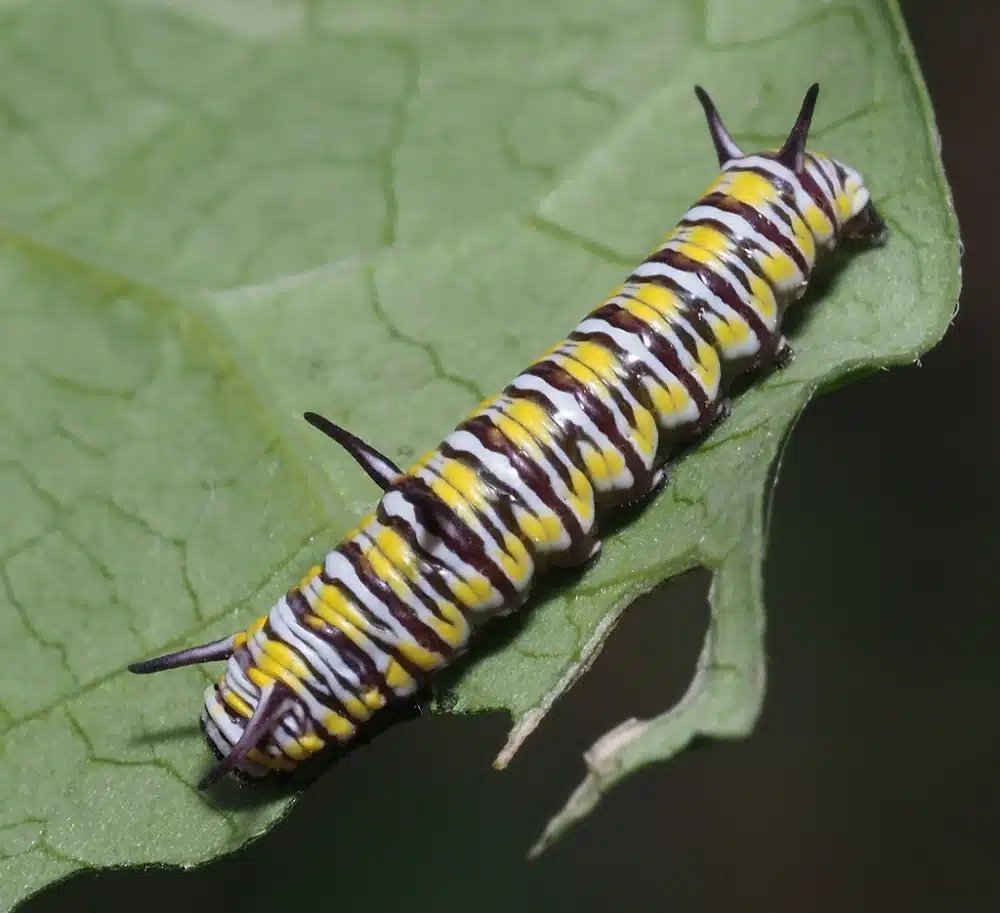
Solider Caterpillars (Danaus eresimus) are a specific species that resembles Monarch Caterpillars in their banded appearance.
They grow 3 pairs of horns. One pair of horns is located on each end while the third one is in the middle of its body.
These horns have black. The bands on its body are black and white. Yellow dots are further distinguishable on the species.
While rare, these dots can be tan on some Soldier caterpillars.
Southern parts of Florida mark the US habitat of these caterpillars. Monarchs, also live and feed on milkweed.
Strangler vines and White vines are secondary host plants of these caterpillars.
4. Ruddy Daggerwing Caterpillar
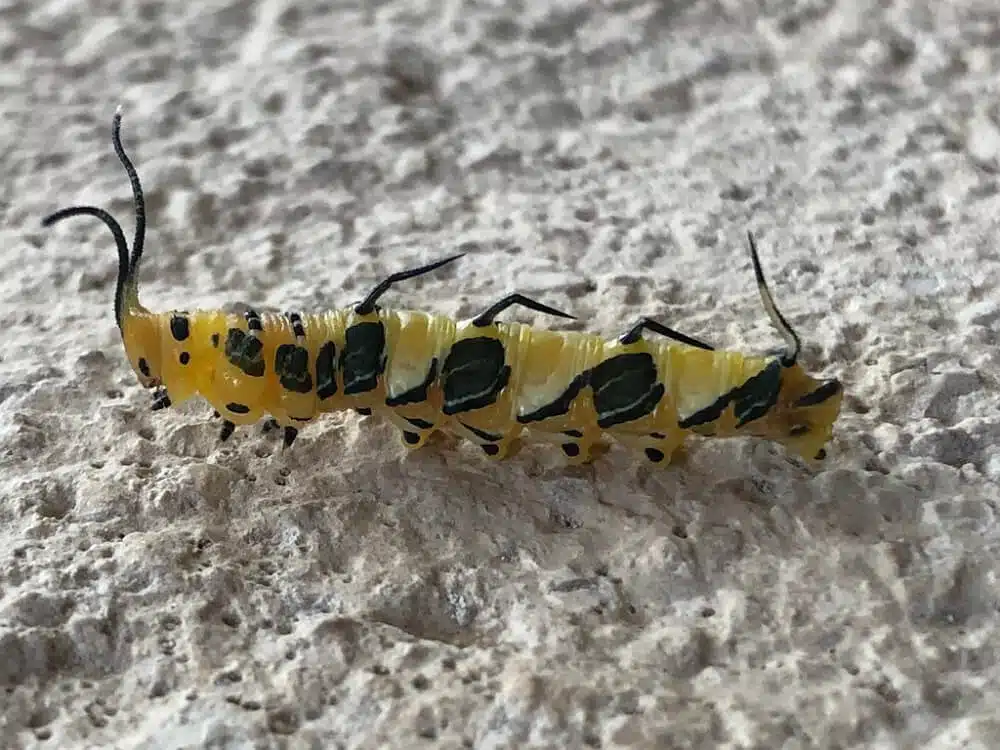
Arizona, Texas, and Florida are common US states where the Ruddy Daggerwing Caterpillar (Marpesia petreus) lives.
Tropical forests are its native habitat but the species lives in the Southern part of Southern US states.
This is a species with partly orange and partly red coloring. It also features fleshy long black horns.
Solitary horns are further seen along its body.
This is a species only seen on various figs, such as climbing figs. It’s the adult butterflies of the species that feed on milkweed, a common host for many North American caterpillars.
5. Queen Caterpillar

Blooflower or butterflyweed is among the common host of The Queen Caterpillar (Danaus gilippus).
This is also a species that looks similar to the African Queen Caterpillar.
Queen Caterpillars of North America are known for their 3 pairs of horns or tentacles.
These have a black color while the body has a mix of black, white, and yellow coloring.
Spotting these caterpillars is only possible on their very specific hosts. Adult Queen butterflies aren’t as demanding when it comes to food.
They can feed both on living and on dead leaves. They can also eat various types of fruits that are in season.
Caterpillars of this species are further known for absorbing toxins so that predators don’t eat them.
6. California Sister Caterpillar
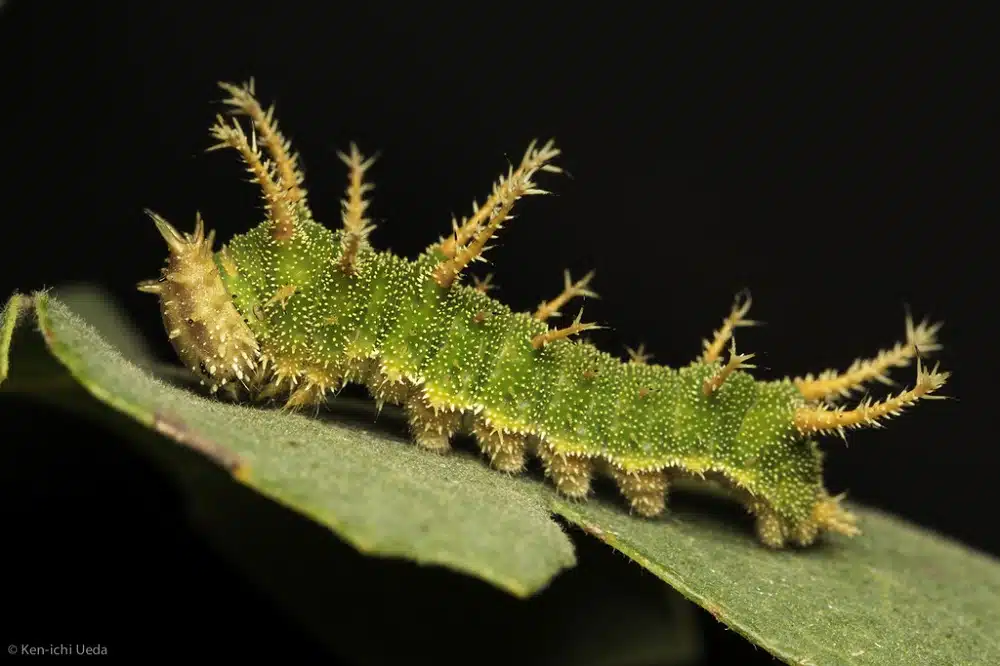
Up to 12 pairs of horns can be seen on the California Sister Caterpillar (Adelpha californica).
This is a widespread species found across multiple West Coast areas from Southern California to Vancouver.
A bright tan or yellow color is specific to the first instar of the species. Horns are visible from this stage.
As it grows, the caterpillar becomes green but its horns remain bright yellow or lemon.
The horns aren’t smooth as they are barbed, making the species look more threatening than it truly is.
You can find the California Sister Caterpillar feed on oak leaves in oak woodlands across various altitudes.
The species can be highly detrimental to oak hosts and it poses a risk of defoliation.
7. Tersa Sphinx Caterpillar

Eastern and Southeastern US territories are the home of the Tesa Sphinx Caterpillar (Xylophanes tersa).
This is a species seen in several broods in Florida, from February to early November.
Caterpillars of this genus have an atypical appearance. There’s only one horn at the rear end which is similar to a tail.
A brown-gray color is specific to the horn, much like the rest of its body.
The Tesa Sphinx Caterpillar has multiple eyespots along its body. This species uses eyespots to keep predators away.
Initially, the caterpillar is green but it turns brown and it grows its singular horn as it matures.
Once an adult, this species moves on to eating nectar from different plants.
8. Regal Moth Caterpillar

Regal Moth Caterpillars (Citheronia regalis) are some of the most striking types of caterpillars in the Eastern parts of North America.
This is a species that impresses with its size as it grows to a length of up to 5.5 inches.
The species has a pale green base color, multiple horns, and short tubercles which keep predators away.
Large orange horns with black tips are specific to its first thoracic segments.
Shorter all-black horns or spines are further distinguishable down its body. This species also shows longer black horns at the read.
This species can be found on hickory and walnut leaves in high numbers, although other hosts have also been confirmed for the species.
9. Honey Locust Moth Caterpillar
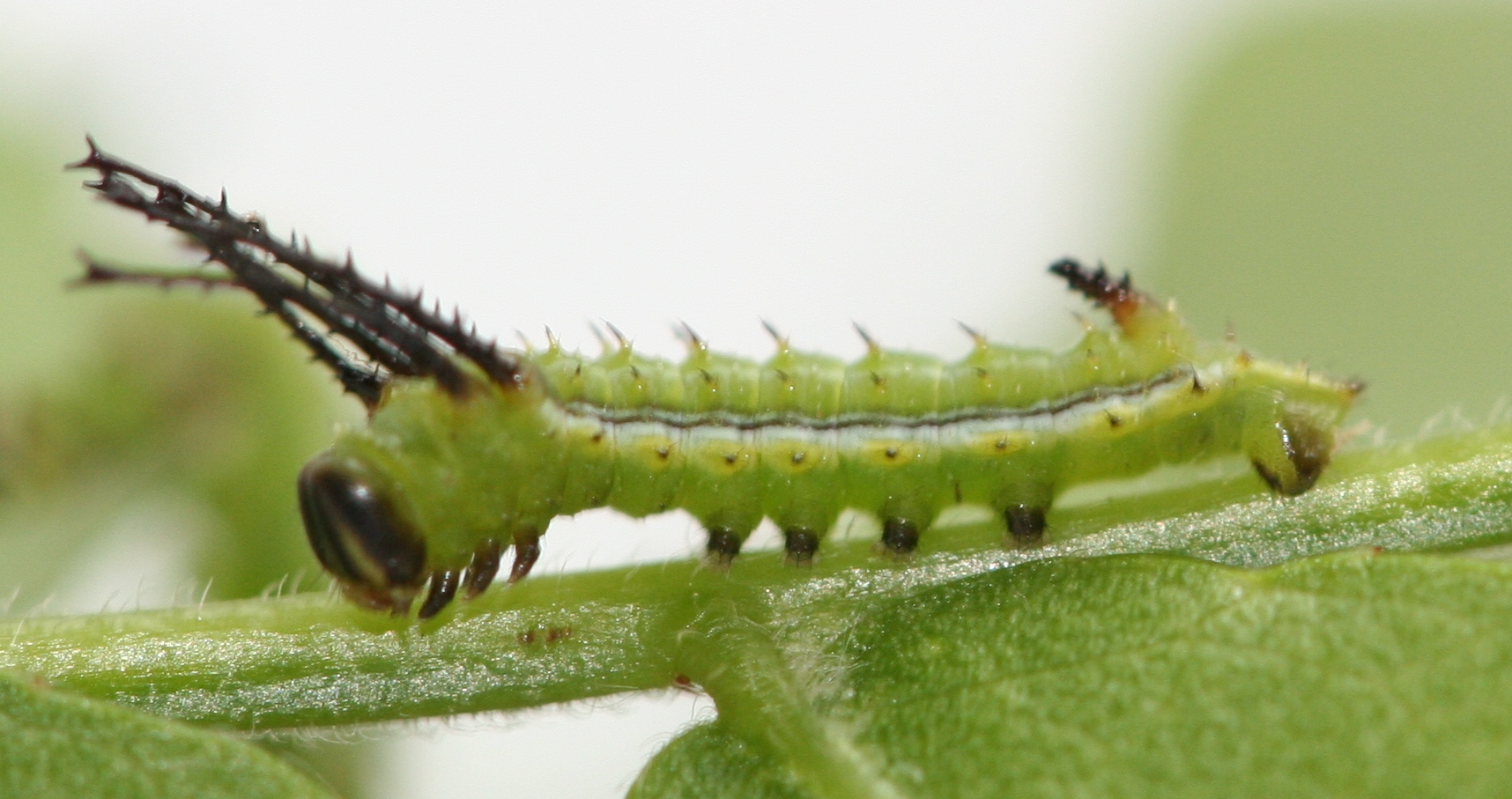
One of the caterpillars with horns that change their appearance as it grows is the Honey Locust Moth Caterpillar (Syssphinx bicolor).
This species shows long black horns in its early instars. 4 horns are seen just behind its head. They have a black color contrasted by a green body with a thin black lateral stripe.
Honey Locust Moth Caterpillars also have a short horn at the rear end and tiny black dots along their body.
The color of the horns and its lateral stripes change as the species reaches its final instar.
Its horns become red-brown and also show tiny white dots.
The black lateral stripes become red and white lateral stripes while its green body also shows tiny white dots.
10. Pine-devil Moth Caterpillar
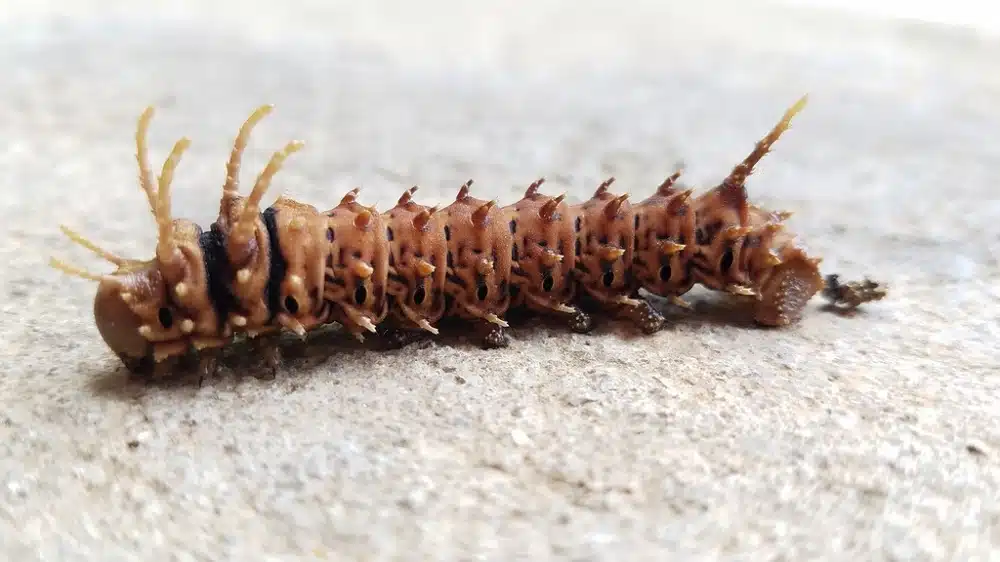
Pine-devil Moth Caterpillars (Citheronia sepulcralis) may sometimes be confused with the similarly-sized Regal Moth Caterpillar
This is a species that has dark brown to gray coloring with multiple pairs of brown horns behind its head.
Growing to a size of up to a few inches, the Pine-devil Moth Caterpillar is native to some of the Eastern Coast states.
While large, it only reaches a maximum length of 3.5 inches, compared to the larger Regal Moth Caterpillar.
This is a species that feeds on different types of pine. It has the most broods in Florida where it lives up to October.
All of the feedings are done in its caterpillar stage as the adult moth doesn’t feed.
11. Horned Spanworm

You can find the Horned Spanworm (Nematocampa resistaria) at high elevations across North America.
This is a species living both in Canada and the US.
Caterpillars of this genus are known for using mimicry techniques to stay safe in front of predators.
They take on the appearance of a stick so that they blend in with their surroundings and host tree.
Short brown horns are seen on its dorsum, which resembles small twigs on a branch.
This brown and yellow species has an irregular shape, looking like a twig.
It grows and lives on different trees such as pine and fir. Wildflowers such as carrots are also among its preferred hosts.
12. Waved Sphinx Caterpillar

This type of caterpillar (Ceratomia undulosa) is named after the wave-like patterns across its body.
A base green color is specific to the species. The wave-like diagonal stripes are yellow. This species shows long red horns as well as red legs.
These red horns are used to keep all types of predators away. For example, this species is often relying on its horns to keep Florida’s Guiana Striped Scorpion away.
A nocturnal moth, the Waved Sphinx lays its eggs on tree leaves which serve as shelter and food for the emerging caterpillar.
The caterpillar feeds on the leaves of ash and oak trees.
13. Saddleback Caterpillar

This type of caterpillar (Acharia stimulea) has a short and wide body with a green saddle-like shaped mark on its back.
Horns are seen on each end of its body. Unlike other species, the Saddleback Caterpillar has short hairs connected to venom glands across its horns.
Touching its horns is painful and also irritating as its venom can lead to prolonged skin irritation.
This type of caterpillar has tens of hosts which means it may be encountered in parks, woodlands, and even gardens.
Some of its typical plant hosts include wisteria, chestnut, and various types of roses
The spines covering its horns aren’t visible in its initial growth stages as they’re most visible in its late instars.
14. Tomato Hornworm

Tomato Hornworm Caterpillars (Manduca quinquemaculata) are named after their host and a single horn.
Located at the rear of its body, this horn has a green-yellow base, a red mid-section, and a black tip.
The green color is specific to the body of The Tomato Hornworm. The species also shows diagonal white lines across its body.
Tiny black dots are further distinguishable along its body.
As its name implies, the species uses tomatoes as its host. It also eats tobacco leaves.
A common sight in gardens, this type of caterpillar eventually turns into a gray to brown moth.
Once an adult, this species uses its elongated mouthparts to suck plant nectar from various species.
15. Tobacco Hornworm

A gray base color and a green base color are specific to the Tobacco Hornworm (Manduca sexta).
Tomatoes, potatoes, eggplants, and tobacco are among their most common foods.
This species is common in gardens where traps or predatory wasps maybe their only true enemies.
A single horn is seen on this caterpillar which varies depending on the color of the species.
Green caterpillars have multicolored horns while gray caterpillars have a black horn.
Blue and black eyespots are further distinguished on the body of this gray morph.
Once an adult, this species migrates to flowers such as pricklyburr for nectar. Large aromatic flowers are preferred.
16. Rosy Maple Moth Caterpillar

The green base color is specific to The Rosy Maple Moth Caterpillar (Dryocampa rubicunda).
This species has 2 black horns, just behind its head. Small black dots are further visible across its body.
Growing up to a length of 1.5 to 2 inches, the Rosy Maple Moth Caterpillars are social creatures.
They feed in groups which reduces predation risks for individuals.
Many types of birds are among their typical predators. Small species such as Blue jays are among their most common predators.
Caterpillars of the species may be seen through the summer on maple trees across North America.
The species has a high presence across multiple provinces in Canada as well as throughout the US with Florida marking its Southern limit.
Once an adult moth, the species turns yellow and pink.
17. Orange-tipped Oakworm

Orange and black colors are specific to the Orange-tipped Oakworm (Anisota senatoria).
A pair of shirt black horns are further visible on the species. These striped caterpillars can be seen in groups, as social feeders in their early instars.
Orange-tipped caterpillars are a high-risk species for different types of hosts.
Oak trees are the main host of the species, with an associated risk of defoliation.
Orange-tipped Oakworms only live on oak tree leaves before pupating. They lower themselves to the ground where they bury themselves before emerging as adult moths.
18. Elephant Hawkmoth Caterpillar

Elephant Hawkmoth Caterpillars (Deilephila elpenor) are born from small green eggs.
They turn dark brown and gray as they emerge as caterpillars. Black horns are further distinguishable on the rear body.
This horn present on the rear body is short and it only appears in the late instars.
As the horn is on the last segment of the body, eyespots are further visible in the late instars.
Elephant Hawkmoth Caterpillars have multiple black, brown, and white eyespots on their sides.
Bedstraw and Himalayan balsam are among the typical hosts of the grass-loving habitat.
This species is found along woodlands, prairies, sandy habitats with little vegetation, or grassland.
Adults feed on plant nectar and become important pollinators of European wildflowers.
19. Red-spotted Admiral Caterpillar

Mimicry techniques are characteristic of the Red-spotted Admiral Caterpillar (Limenitis arthemis).
This is a species known for its tan, brown, and white coloring and irregularly-shaped body which makes it similar to bird droppings.
This mimicry technique allows the species to be safe in front of potential predators.
Horns are also visible on the caterpillar, particularly later in its growth process.
Its horns have a dark brown to black color.
Widely distributed across North America, The Red-spotted Admiral Caterpillar is a species that feeds on tree leaves.
Aspen, poplar, and various types of trees in the willow family are suitable hosts for the species.
20. White-lined Sphinx Caterpillar

White-lined Sphinx Caterpillars (Hyles lineata) are among the multiple species which have one horn and which is located at the rear.
This horn is often mistaken for a stinger, but it has no type of real use apart from imitating a stinger.
White-lined Sphinx Caterpillars may be green or yellow. Their horn may also differ in coloring based on the morph.
In rare cases, the caterpillar has a light green or lime green color which shows a black tip horn.
A wide range of hosts is specific to this caterpillar. This includes both flowers and legumes but trees such as elm also spark their interest.
In gardens, this single-horn caterpillar feeds on tomatoes and apples but it may also feed on short flowers such as five o’clock.
21. Rustic Sphinx Caterpillar

A single horn is specific to The Rustic Sphinx Caterpillar (Manduca rustica). This species has a horn at the rear end, similar to a singer.
The green coloring is specific to this family of caterpillars. Multiple white diagonal stripes are further seen on its sides.
Red dorsal colors start to appear on its dorsum as the species goes from one instar to another.
Its capacity to raise its head above the ground is what inspired the name of this species.
Jasmin and gardenia are among the typical hosts of the species.
Once adults, gray, brown, and white colors are seen across the wings of the moth.
This species is rarely spotted as an adult as Rustic Sphinx Moths only fly at night.
22. Zebra Longwing Caterpillar

An atypical appearance is specific to the Zebra Longwing Caterpillar (Heliconius charithonia).
This caterpillar shares the same black and white colors as the adults of the species which inspired its name.
The Zebra Longwing Caterpillar has a base white color, unlike most other species that are green.
Multiple long black horns are further distinguishable on this species.
Unlike other species with fleshy horns, the Zebra Longwing Caterpillar has tens of horns covering its body.
These horns are also longer than the horns of other species.
Tiny red or black dots are further seen across its body, in between its black horns.
23. Pawpaw Sphinx Caterpillar

American Pawpaw is the main host of the Pawpaw Sphinx Caterpillar (Dolba hyloeus).
This is a horned species dominated by various shades of green through all of its instars.
Pale green is initially seen on its body while dark green is distinguished while the species grows.
White diagonal stripes decorate the sides of its body.
A single horn is seen on the last abdominal plate of the species. Small coloring differences in the horn are seen as it grows.
The horn can be black or green at the base at black at the tip.
24. Saddled Prominent Caterpillar
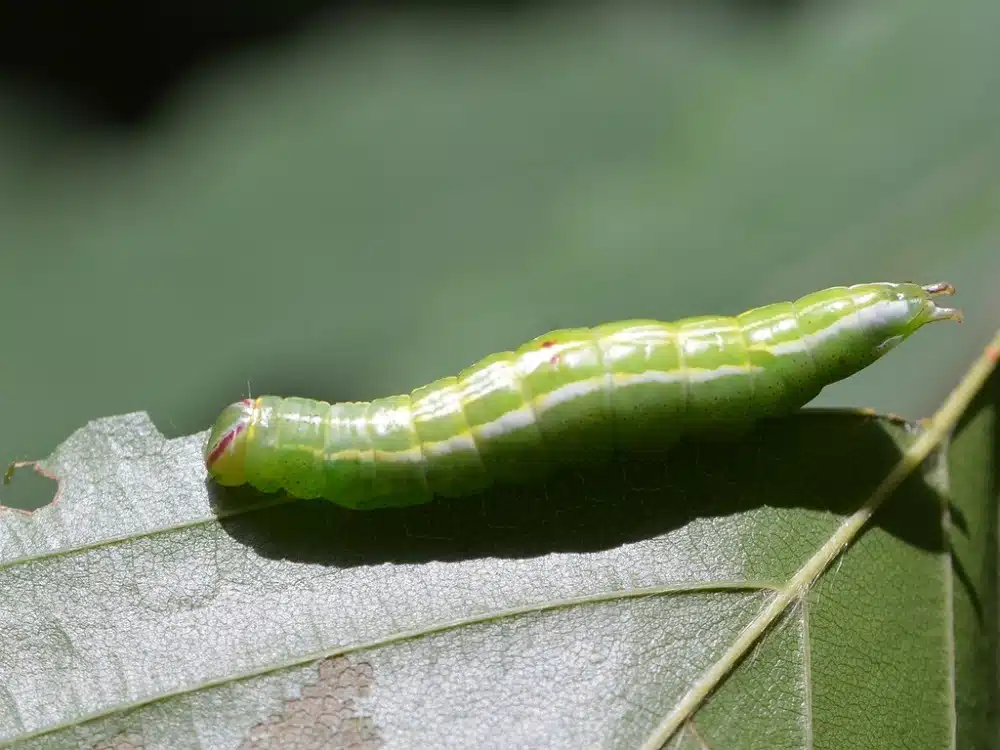
Saddled Prominent Caterpillars (Cecrita guttivitta) are minor or major pests, depending on their location.
Found in gardens, this species can feed on the leaves of trees and plants. Apple and walnut leaves are often eaten by these caterpillars.
Blueberry leaves are also consumed by the species.
A light green color is specific to this species which also has 2 short yellow horns at the rear end.
White lateral sections showing tiny black dots are further distinguishable on the grown caterpillar.
A yellow mid-dorsal stripe is also seen on the species.
25. Dragon-headed Caterpillar

Dragon-headed Caterpillars (Polyura athamas) are named after their atypical head with horns.
The head of the species has often been compared to the head of dragons.
There are 4 angled horns on its head. Both the head and the horns have uniform green coloring.
Its body is also green and it shows white bands and stripes.
Apart from its atypical horns, this species also has atypical pupa coloring. It maintains its green and white colors into its pupal stage.
Leaves are the main food of the species and its horns are used to keep birds and frogs away as these are some of its most common predators.
This species maintains its appearance through its instars, despite multiplying its size numerous times.
It measures just 3mm in its first instar to reach a maximum length of 30mm in its 5th and final instar.
26. Pink-striped Oakworm

Eastern North American territories are the home of the Pink-striped Oakworm (Anisota virginiensis).
Green base coloring with pink longitudinal stripes is specific to the Pink-striped Oakworm.
This is a species that shows a pair of long black horns and multiple shorter horns along its body.
The species also starts to show tiny white dots along its body as it grows.
All of its feedings are specific to its caterpillar stage as adult Pink-striped Oakworm moths only live for a few days and don’t feed.
There’s a small risk of oak tree defoliation with this species. Actual defoliation cases are rare as these caterpillars often end up eaten by birds.
Emerged adults carry some coloring from their caterpillar stages. Pink and orange-red colors are specific to the hairy Pink-Striped Oakworm Moth.
27. Spiny Oakworm

Long black horns are seen on the head of the Spiny Oakworm caterpillar (Anisota stigma).
This species has orange to pink coloring or pale orange base colors.
Orange or brown nuances are also specific to the emerged Spiny Oakworm Moth.
Rare brown morphs are also confirmed for this species.
Brown base coloring is backed by darker brown head colors. Black horns are also specific to this morph.
As it grows, the caterpillar starts to grow its horns as well. Tiny black spines similar to horns are further distinguishable on its body.
Oaktree leaves represent the base food of the species as oak trees are their primary host.
Other hosts are also being confirmed for the species. Hazel tree leaves are among its secondary but rare hosts.